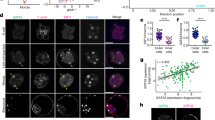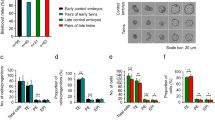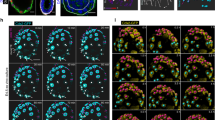Abstract
THE primary observable event of differentiation in the mammalian embryo is the formation of the trophectoderm and the inner cell mass (ICM). Differentiation first becomes evident in the mouse embryo during early blastulation and is clear and apparently irreversible by the 60-cell blastocyst stage. The 45 or so trophectoderm cells surround a blasto-coelic cavity containing the ICM, they pump fluid, are phagocytic, are interconnected through junctional complexes and can elicit an implantation response in the uterus1. The trophectoderm gives rise to the ectoplacental trophoblast, primary and secondary trophoblastic giant cells and probably also to extra-embryonic ectoderm1,2. The cells of the ICM are less evidently differentiated, being rounded, sticky cells somewhat like cleavage stage blasto-meres, but having lost the capacity to form trophoblast3,4. The ICM gives rise to embryonic ectoderm, and to both extra-embryonic and embryonic endoderm1,2,5. Although the fully differentiated cells of the blastocyst are distinguishable by structural and functional criteria, adequate markers of differentiation are not available for the morula stage, when the determinative events leading to differentiation are presumed to occur. Thus, attempts to detect blastomeres with a commitment to one or the other differentiated cell type have relied for an index of commitment on the subsequent behaviour of genetically or physically marked blastomeres combined in various spatial relations with other distinguishable blastomeres. This experimental approach is open to criticism. Frequently, many cell divisions must elapse before suitable genetic markers can be detected with sufficient sensitivity, and the procedures involve artificial manipulation and therefore possibly modification of blastomeres to test their potency2,6. The detection of a cell marker which is produced in situ in the earliest stages of differentiation, and one which is detectable by highly sensitive techniques would circumvent both of these problems. We describe here the detection of tissue specific markers which may prove to fulfil these criteria.
This is a preview of subscription content, access via your institution
Access options
Subscribe to this journal
Receive 51 print issues and online access
$199.00 per year
only $3.90 per issue
Buy this article
- Purchase on Springer Link
- Instant access to full article PDF
Prices may be subject to local taxes which are calculated during checkout
Similar content being viewed by others
References
Gardner, R. L., and Papaioannou, V. E., in The Early Development of Mammals (edit. by Balls, M., and Wild, A. E.), 107–132 (Cambridge University Press, 1975).
Gardner, R. L., and Johnson, M. H., in Cell Patterning, Ciba Found. Symp. No. 29, 183–200 (Excerpta Medica, North Holland, Amsterdam, 1975).
Rossant, J., J. Embryol. exp. Morph., 33, 979–990 (1975).
Rossant, J., J. Embryol. exp. Morph., 33, 991–1001 (1975).
Gardner, R. L., Papaioannou, V. E., and Barton, S. C., J. Embryol. exp. Morph., 30, 561–572 (1973).
Gardner, R. L., and Johnson, M. H., Nature new Biol., 246, 86–89 (1973).
Whittingham, D. G., J. Reprod., Fert. Suppl., 14, 7–21 (1971).
O'Farrell, P. H., J. biol. Chem., 250, 4007–4020 (1975).
Van Blerkom, J., and Manes, C., Devl Biol., 40, 40–51 (1974).
Van Blerkom, J., and Brockway, G., Devl Biol., 44, 148–157 (1975).
Laskey, R. A., and Mills, A. D., Eur. J. Biochem., 56, 335–341 (1975).
Van Blerkom, J., and Runner, M., J. exp. Zool., (in the press).
Herbert, M. C., and Graham, C. F., Curr. Topics dev. Biol, 8, 152–178 (1974).
Hillman, N., Sherman, M. I., and Graham, C. F., J. Embryol. exp. Morph., 28, 263–278 (1972).
Tarkowski, A., and Wroblewski, J., J. Embryol. exp. Morph., 18, 155–180 (1967).
Author information
Authors and Affiliations
Rights and permissions
About this article
Cite this article
VAN BLERKOM, J., BARTON, S. & JOHNSON, M. Molecular differentiation in the preimplantation mouse embryo. Nature 259, 319–321 (1976). https://doi.org/10.1038/259319a0
Received:
Accepted:
Issue Date:
DOI: https://doi.org/10.1038/259319a0
This article is cited by
-
Radioactive labeling of proteins in cultured postimplantation mouse embryos I. Influence of the embryo preparation method
In Vitro Cellular & Developmental Biology (1989)
-
Role of the blastocoele microenvironment in early mouse embryo differentiation
Nature (1980)
Comments
By submitting a comment you agree to abide by our Terms and Community Guidelines. If you find something abusive or that does not comply with our terms or guidelines please flag it as inappropriate.



